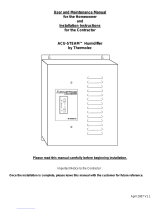
2060 rue Lucien-Thimens,
Montréal, Québec, Canada H4R 1L1
TÉL: 514-336-9130
FAX: 514-336-3270
www.thermolec.com
Electric Heating and Controls
Installation, Operating and Maintenance Instructions for
THERMOLEC electric heaters - type FC & SC - (or tubular FT & ST).
1 - Mechanical Installation of THERMOLEC heaters.
1.1 Handling. 1. Remove the shipping covers just before installation.
2. Inspect the heater carefully and report any damage to the manufacturer.
DO NOT INSTALL A DAMAGED HEATER.
1.2 Installation.
Heater Position
1.2.1 The axis of the duct must always be perpendicular to the face of the heater.
1.2.2 The air direction may be either vertical or horizontal, but when the unit is installed horizontally, the thermal cut-outs
must be on top.
1.2.3 Heaters with SCR controls are not made for universal installation. Follow the label on the heater for proper
installation. Should there be any confl icts, contact Thermolec before installing the heater.
1.2.4 The heater can not be installed in an attic.
Model SC or ST (Slip-in type) (Please see drawings page 4).
1.2.5 Cut an opening in the side of the duct.
1.2.6 Slip the heater into the duct until the hole is completely covered by fl anges around the heater.
1.2.7 Fasten the heater to the duct with sheet metal screws and seal openings with a suitable sealing compound.
1.2.8 If the heater is heavy, use additional hangers to support the heater.
Model FC or FT (Flanged type) (Please see drawings page 4).
1.2.9 Flange both ends of the duct outwards on three sides to match the heater’s fl anges.
1.2.10 Fasten the heater to the duct with sheet metal screws. (For heavy heaters, use nuts and bolts and additional
hangers to support the heater).
1.2.11 Seal openings with a suitable sealing compound.
1.2.12 Spacing Requirements to obtain Optimal air distribution over the heating elements of duct heaters are:
(Please see drawings page 4).
Note: Distances may vary for heaters installed in air handling units (AHU).
• 24 inches between the heater and fi lter frames.
** inches between the heater and elbows in the duct.
** inches between the heater and branches in the duct.
** inches between the heater and sharp transitions of the duct.
** = minimum distance = the largest of two dimensions (W or H) up to 48”.
Examples: heater of 12” x 12” minimum distance 12”.
heater of 30” x 12” minimum distance 30”.
Heater of 60” x 30” minimum distance 48”.
• 48 inches between the heater and a double outlet fan, except with split duct design.
•30 inches between the heater and access doors or diffusers, except if a metal screen is supplied with the heater.
• 1 inch between the duct at the outlet side and combustible materials for a length of 72”, for vertical ducts only.
• For the fl anged type, 24 inches between the control box cover and obstructions to allow space for installation and
service.
• For the slip-in type, width of the duct (dimension W) + depth of the control box + ten (10) inches between the
control box cover and obstructions to allow slipping the heater out the duct and to allow safe servicing.
March 2022





